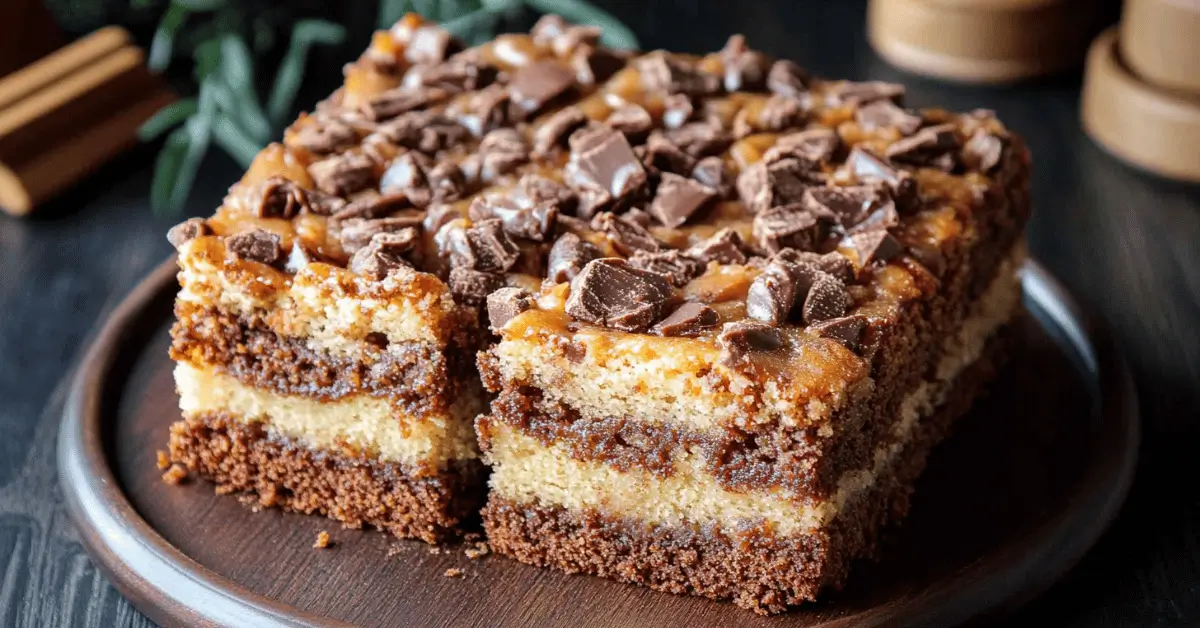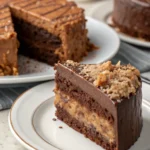If there’s one cake that defines indulgence and tradition in a single bite, it’s the Baker’s German choc cake recipe. This dessert is more than just layers of rich chocolate and gooey coconut-pecan frosting — it’s a piece of culinary history wrapped in sweetness. In this guide, we’ll take you deep into the origins of this iconic recipe, share every step to make it from scratch, and explore why Baker’s chocolate makes all the difference.
From understanding the difference between Baker’s chocolate and German chocolate to troubleshooting common baking mistakes, this article covers it all. We’ll also give you delicious variations, storage tips, and substitutions for when Baker’s chocolate is out of reach. Plus, don’t miss our in-depth look at the brand behind Baker’s chocolate, and what’s happened to it over time.
Looking for inspiration? Try our Soft Sourdough Sandwich Bread recipe while you wait for your cake layers to cool!
Jumo to:
History & Origins of Baker’s German Chocolate Cake
The Birth of a Classic: Where It All Started
You might assume Baker’s German choc cake recipe came straight from Germany, but surprise — it’s 100% American. The dessert’s roots go back to 1957 when a Texas homemaker sent in a recipe to a Dallas newspaper. That recipe used Baker’s German’s Sweet Chocolate, which was originally developed by Samuel German in the 1850s for the Baker’s Chocolate Company. Hence the name “German’s” chocolate cake.
So no, it wasn’t from Berlin or Munich. Instead, it gained popularity across the U.S. for its incredible richness and layered sweetness. The cake features delicate chocolate sponge, but what sets it apart is the unmistakable caramel-like coconut and pecan frosting.
This dessert became so loved that it made its way into households and bakeries nationwide. What started as a home-baked submission quickly turned into a baking staple. Even decades later, searches for “Baker’s German choc cake recipe” remain high, proving it still has a firm hold in American kitchens.
Who Was ‘Baker’? Debunking the Name and Origin
Let’s clear up a common misconception: Baker’s chocolate has nothing to do with your neighborhood baker. The brand dates back to the 1700s and was named after Dr. James Baker, who co-founded America’s first chocolate mill. Samuel German created a sweeter formulation of their chocolate in the 19th century, leading to the launch of German’s Sweet Chocolate.
So when we refer to the Baker’s German choc cake recipe, we’re talking about a cake made with German’s Sweet Chocolate by Baker’s, not a German-style cake or a cake for bakers. Confusing? Maybe. But delicious? Absolutely.
Check out our blog archive for more baking inspirations rooted in history and flavor.
What Makes Baker’s German Chocolate Cake Special
The Unique Flavor Profile: Coconut, Pecan & Sweet Chocolate
So what really makes the Baker’s German choc cake recipe stand out from all the other chocolate cakes out there? It all comes down to flavor. Unlike standard chocolate cakes that focus on intense cocoa or dark chocolate bitterness, this one leans toward the sweeter, creamier side — all thanks to Baker’s German Sweet Chocolate.
This chocolate isn’t as dark or rich as semisweet or bittersweet varieties. Instead, it’s mellow, lightly sweet, and perfectly smooth — a great balance when paired with the sugary, nutty frosting.
Speaking of frosting, that coconut-pecan topping is the cake’s signature. It’s sticky, crunchy, and rich in buttery caramel flavor. The contrast between the fluffy chocolate sponge and the dense frosting is just chef’s kiss.
There’s nothing else quite like it. When you bite into a slice made from the Baker’s German choc cake recipe, you’re not just tasting chocolate — you’re tasting a harmony of texture and taste: smooth, sweet, toasty, and tender all at once.
Don’t miss our Salmon Patties Recipe — a savory balance if you’re planning a full homemade meal to follow dessert.
Baker’s Chocolate vs. Other Baking Chocolates
Now let’s talk chocolate. If you’re following a Baker’s German choc cake recipe, it’s important to know why the original Baker’s German Sweet Chocolate matters. Unlike cocoa powder or unsweetened chocolate, Baker’s German is pre-sweetened and made with a unique blend that creates a smoother melt and sweeter bite.
Here’s a quick comparison table:
| Chocolate Type | Sweetness Level | Texture | Flavor Notes | Used In |
|---|---|---|---|---|
| Baker’s German Sweet Chocolate | Medium-High | Smooth Melt | Mild, sweet, buttery | German choc cake |
| Semi-sweet Chocolate | Medium | Firm Melt | Slightly bitter, rich | Cookies, brownies |
| Unsweetened Chocolate | None | Dry/Brittle | Intense, bitter | Baking w/ sugar added |
| Dark Chocolate (70%+) | Low | Firm | Deep cocoa, slightly bitter | Gourmet baking |
If you don’t have Baker’s chocolate on hand, it’s tempting to use substitutes. But know this: the flavor won’t be quite the same. That’s why sticking with the original — or at least getting close with a homemade blend — really preserves the magic of this cake.
The sweet spot of this dessert is balance, and using the right chocolate is half the work. The rest is love, attention, and that dreamy frosting.
Looking for more baking tips? Don’t miss our dessert section filled with easy, indulgent recipes.
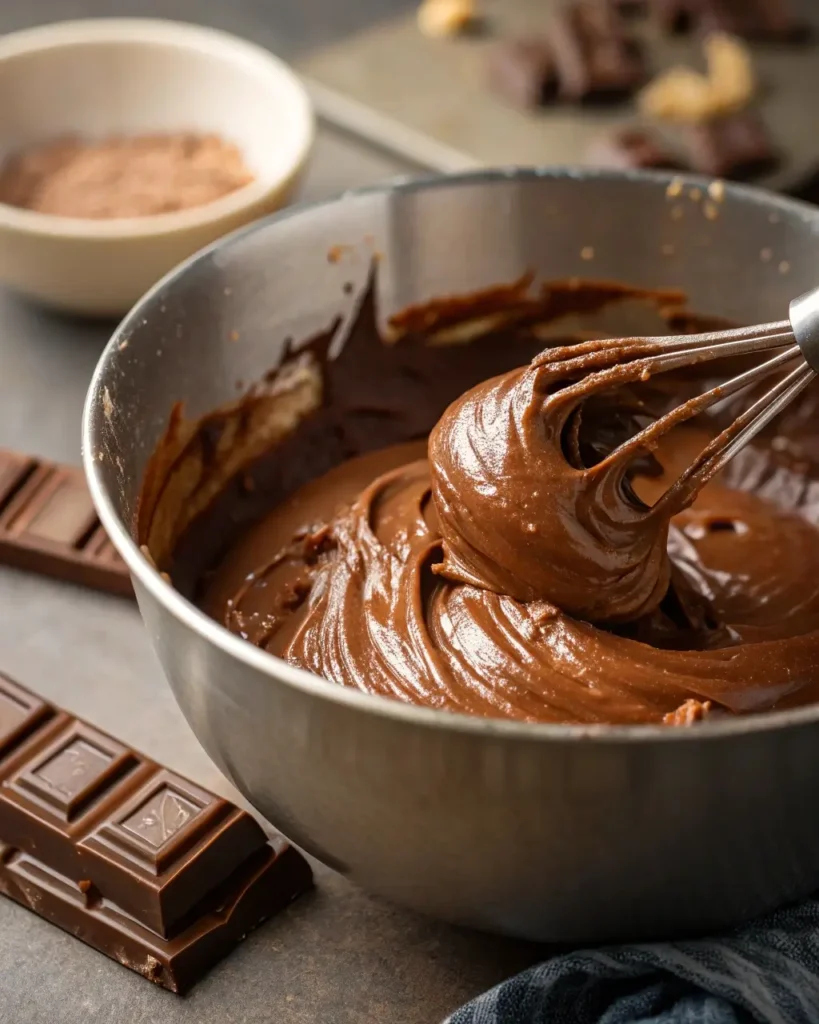
Ingredients You’ll Need for a Traditional Baker’s German Choc Cake Recipe
Essential Ingredients (Including Baker’s Chocolate)
Getting your ingredients right is the first step in mastering the Baker’s German choc cake recipe. Unlike a basic chocolate cake, this one needs a specific combo of sweet chocolate, buttermilk, and that unforgettable coconut-pecan frosting.
Here’s a complete ingredient list for a classic 3-layer, 9-inch cake:
For the Cake:
- 1 package (4 oz.) Baker’s German Sweet Chocolate, chopped
- ½ cup boiling water
- 2 cups sugar
- 1 cup (2 sticks) unsalted butter, softened
- 4 large eggs, separated
- 1 tsp vanilla extract
- 2½ cups cake flour (or all-purpose if needed)
- 1 tsp baking soda
- ½ tsp salt
- 1 cup buttermilk
For the Coconut-Pecan Frosting:
- 1 can (12 oz.) evaporated milk
- 1½ cups sugar
- ¾ cup (1½ sticks) butter
- 4 large egg yolks
- 1½ tsp vanilla extract
- 2 cups sweetened flaked coconut
- 1½ cups chopped pecans
This is the classic combo for the baker’s german choc cake recipe, and it’s one that’s stood the test of time. Each ingredient has a purpose — from the fluffiness of the whipped egg whites to the silky sweet melt of Baker’s chocolate.
Optional Add-ins & Substitutions
While purists may stick to the original, you’ve got flexibility. Maybe you don’t have Baker’s chocolate on hand or need a dairy-free option. Here’s what you can swap without losing the soul of the cake:
| Ingredient to Replace | Substitute Option | Note |
|---|---|---|
| Baker’s German Chocolate | 1 oz unsweetened chocolate + 1 tbsp sugar (x4) | Mimics sweetness & cocoa level |
| Buttermilk | 1 cup milk + 1 tbsp vinegar or lemon juice | Let sit 5–10 mins |
| Evaporated Milk | Coconut milk (unsweetened) | Adds a tropical twist |
| Pecans | Walnuts or almonds | Toast for best flavor |
| Cake Flour | All-purpose + cornstarch (2.5 cups flour – 5 tbsp, add 5 tbsp cornstarch) | DIY cake flour |
You can even get creative with the frosting — try a splash of bourbon or a sprinkle of cinnamon for a bold kick.
Discover great ideas like our Soft Sourdough Sandwich Bread if you’re in the mood for more homemade goodness while your cake bakes.
With the right ingredients, the Baker’s German choc cake recipe isn’t just doable — it’s unforgettable.
Step-by-Step Baker’s German Chocolate Cake Recipe Instructions
Making the Cake Layers: Tips for Perfect Texture
Before you even turn on the oven, know this: the key to the Baker’s German choc cake recipe is precision and patience. Every layer plays a role, and it starts with the batter.
Step-by-step for the cake layers:
- Preheat your oven to 350°F (175°C). Grease and flour three 9-inch round baking pans, and line bottoms with parchment paper for easy removal.
- Melt the chocolate: Place the chopped Baker’s German Sweet Chocolate in a small bowl. Pour the boiling water over it and stir until fully melted. Let it cool slightly.
- Cream butter and sugar together in a large mixing bowl using an electric mixer on medium speed until light and fluffy.
- Separate your eggs: Add egg yolks one at a time, beating well after each. Save the whites for later.
- Add vanilla and melted chocolate to the creamed mixture. Mix until smooth.
- Sift flour, baking soda, and salt into a bowl. Add the dry ingredients alternately with buttermilk, beginning and ending with the flour mixture. Mix gently but thoroughly.
- Beat egg whites in a clean bowl until stiff peaks form. Gently fold into the batter — this step is crucial for a light, airy texture.
- Divide the batter evenly among the three pans. Tap each on the counter to remove air bubbles.
- Bake for 30–35 minutes, or until a toothpick inserted in the center comes out clean.
- Cool the layers in pans for 10 minutes, then turn out onto wire racks to cool completely.
Want to multitask while the layers bake? Don’t miss our easy dinner recipes that pair perfectly with dessert prep.
Creating the Famous Coconut Pecan Frosting
This frosting is the soul of any Baker’s German choc cake recipe. It’s sweet, nutty, and slightly caramelized — and making it from scratch is way easier than you think.
Steps for frosting:
- Combine evaporated milk, sugar, butter, and egg yolks in a medium saucepan.
- Cook over medium heat, stirring constantly for 10–12 minutes or until thickened and golden. It should coat the back of a spoon.
- Remove from heat and stir in vanilla, coconut, and chopped pecans.
- Let the frosting cool, stirring occasionally, until it’s spreadable — about 30 minutes.
This luscious, sticky frosting is rich and textured, providing the signature contrast to the soft chocolate layers.
Assembly and Finishing Touches
- Place the first cake layer on your serving plate.
- Spread a third of the frosting on top — not the sides.
- Repeat with remaining layers and frosting.
- Optional: Garnish with extra pecans or a light sprinkle of coconut for that bakery-style look.
If you follow the Baker’s German choc cake recipe step-by-step, your cake should be tall, moist, and slice like a dream.
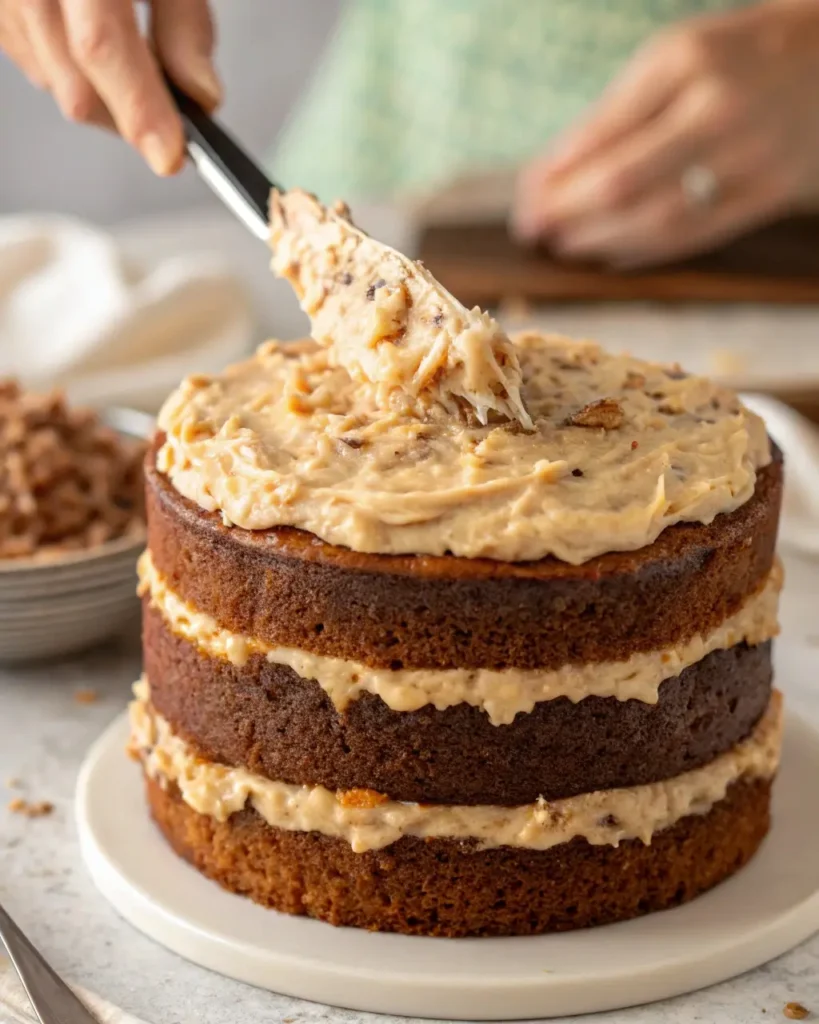
Substitutes and Variations of Baker’s German Choc Cake
What If You Can’t Find Baker’s Chocolate? Best Substitutes
You’ve prepped everything for the perfect Baker’s German choc cake recipe, only to realize your pantry is missing the star ingredient — Baker’s German Sweet Chocolate. Don’t panic. There are some effective substitutes that will still give you that signature sweet chocolate flavor, even if you’re improvising.
Here’s a go-to homemade substitution:
| Ingredient Needed | Substitute | Instructions |
|---|---|---|
| 4 oz Baker’s German Sweet Chocolate | 4 oz unsweetened chocolate + 4 tbsp sugar | Melt together and stir well before using |
| Baker’s brand chocolate (unavailable in stores) | Ghirardelli Sweet Chocolate or Hershey’s Milk Chocolate Bars | Adjust sugar in recipe if overly sweet |
If you’re using unsweetened chocolate, always increase your sugar slightly to balance out the bitterness. The original Baker’s German choc cake recipe depends on the mild sweetness of the chocolate — it’s not as bold as dark chocolate and not as milky as standard bars. Get as close as you can to match that flavor profile.
Also, avoid using cocoa powder as a substitute. It lacks the fat and texture of real chocolate and can leave the cake dry and crumbly.
Gluten-Free, Eggless, and Modern Twists
The traditional recipe is a hit, but that doesn’t mean you can’t adapt it to your lifestyle. Whether you’re going gluten-free, avoiding eggs, or just trying to modernize the flavor, the Baker’s German choc cake recipe can evolve beautifully.
Gluten-Free Version:
- Swap cake flour with a 1:1 gluten-free baking mix.
- Add ½ tsp xanthan gum if your mix doesn’t include it.
- Check your chocolate label for hidden gluten.
Eggless Variation:
- Replace each egg with ¼ cup unsweetened applesauce or a commercial egg replacer.
- For the frosting yolks, try 1 tbsp cornstarch + 2 tbsp water per yolk.
Healthier Modern Takes:
- Use coconut sugar or maple syrup in place of white sugar for a deeper flavor.
- Swap butter with avocado oil in the cake for a lighter, softer crumb.
- Add a teaspoon of espresso powder to the cake batter to intensify the chocolate taste.
And if you’re feeling adventurous? Try baking them as cupcakes. Simply reduce the bake time to 18–20 minutes and keep the frosting as-is.
Looking for more fun adaptations? Check out our dessert recipe ideas for inventive treats that don’t sacrifice flavor.
The beauty of the Baker’s German choc cake recipe is that it’s flexible without losing its nostalgic charm. Whether you stick to tradition or go rogue, the result will still be a showstopper.
German Chocolate Cake vs. Regular Chocolate Cake
Key Differences in Taste and Texture
While both cakes may look similar at first glance, the Baker’s German choc cake recipe delivers an entirely different experience than your average chocolate cake. The most obvious difference? Flavor and texture.
Here’s how they stack up:
| Feature | Regular Chocolate Cake | German Chocolate Cake |
|---|---|---|
| Chocolate Type | Unsweetened or dark cocoa powder | Baker’s German Sweet Chocolate |
| Frosting | Buttercream or ganache | Coconut-pecan caramel |
| Texture | Rich, moist, often dense | Light, fluffy, soft |
| Sweetness Level | Depends on cocoa content | Sweeter due to German chocolate |
| Flavor Profile | Deep, bitter chocolate | Sweet, nutty, buttery balance |
With a regular chocolate cake, you often get intense cocoa flavor and a smooth or fluffy frosting. But the Baker’s German choc cake recipe leans into a delicate, sweet richness. The chocolate layers are airy but flavorful, and that homemade coconut-pecan frosting? It brings texture, chew, and a caramel twist that’s completely unique.
In fact, many bakers say the frosting steals the show — and they’re not wrong. The combo of toasted pecans, shredded coconut, and a buttery base is something no regular chocolate cake can touch.
Check out more sweet comparisons in our dessert blog to see how your favorites stack up.
Ingredient and Preparation Comparison
One of the most important things to remember when baking is how different ingredients can dramatically shift results. The Baker’s German choc cake recipe uses melted sweet chocolate, not cocoa powder, which adds fat and smoothness to the batter. That’s a game-changer.
Let’s break this down:
| Element | Baker’s German Choc Cake | Regular Chocolate Cake |
|---|---|---|
| Primary Chocolate | Melted Baker’s German Sweet Chocolate | Cocoa powder or unsweetened chocolate |
| Fat Source | Butter + chocolate | Butter/oil + cocoa |
| Liquid | Buttermilk | Milk or water |
| Eggs | Whites separated and whipped | Whole eggs, mixed in |
The method matters too. In the Baker’s German choc cake recipe, whipping the egg whites separately adds lightness and lift. That’s something a standard chocolate cake often skips.
Also, that frosting isn’t just slathered on top. It’s layered between cakes, stacked high, and left dripping down the sides — rustic and decadent all at once.
So while a chocolate cake might satisfy a quick craving, German chocolate cake delivers a full-on dessert experience. It’s rich, it’s indulgent, and most of all — it’s memorable.
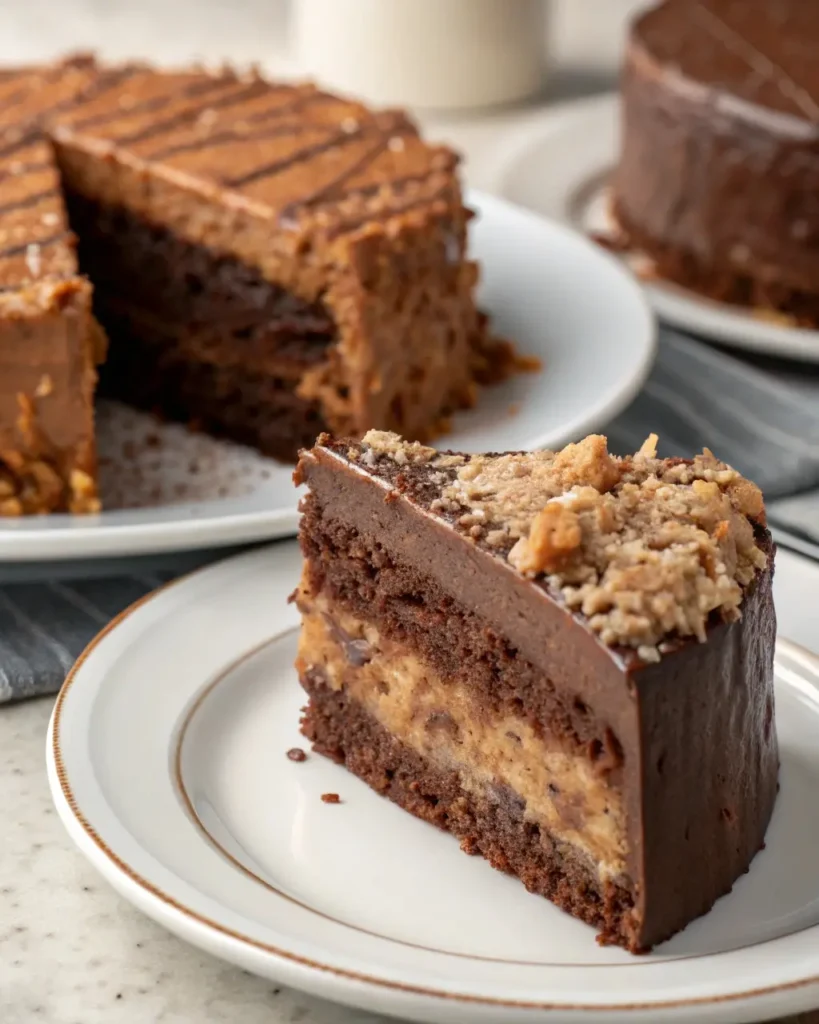
Common Mistakes to Avoid When Baking German Chocolate Cake
Overmixing, Overbaking, and Frosting Fails
You’ve followed every step of the Baker’s German choc cake recipe, but somehow your cake is dry, dense, or the frosting just won’t set. Let’s talk about where things often go wrong.
1. Overmixing the Batter
This cake depends on a light and fluffy crumb, and overmixing ruins that. Once you add the dry ingredients, mix just until combined. Then, when folding in those whipped egg whites, use a spatula and gentle strokes to keep the batter airy. If it looks a little streaky — that’s fine!
2. Incorrect Chocolate Handling
Using the wrong type of chocolate or not melting it properly changes everything. The Baker’s German choc cake recipe requires melted Baker’s German Sweet Chocolate, not unsweetened or dark chocolate bars. Always let it cool slightly before mixing into your batter so it doesn’t cook the eggs or curdle the butter.
3. Dry Cake Layers from Overbaking
German chocolate cake should be soft and slightly moist. Bake it too long and it becomes dry and crumbly. Stick to the 30–35 minute window and check with a toothpick. It should come out with a few moist crumbs — not bone dry.
4. Frosting Not Thickening
If your coconut-pecan frosting is runny, it probably wasn’t cooked long enough or at the right temperature. You need to stir it constantly over medium heat until it thickens to a custard-like consistency. Skipping this step results in a frosting that slides right off your layers.
Discover more helpful baking tips in our recipe archive — every dessert has its secret.
Chocolate Quality and Its Impact
Another big misstep? Choosing the wrong chocolate quality. The Baker’s German choc cake recipe is built around one key flavor: smooth, sweet chocolate. Lower-quality chocolate will melt unevenly, taste waxy, or overpower the coconut and pecan in the frosting.
Here’s what to look for:
- Minimum 48% cacao content for sweetness and flavor.
- A smooth melt (no grainy or chalky texture).
- Trusted brands like Baker’s, Ghirardelli, or Lindt (sweet varieties).
Using off-brand or low-cocoa chocolate throws the flavor balance off. German chocolate cake is about harmony, not heaviness.
So remember: measure carefully, melt gently, mix minimally, and bake precisely. The Baker’s German choc cake recipe rewards you for patience and precision — and punishes shortcuts.
Storing, Serving & Pairing Your German Chocolate Cake
How to Store for Freshness and Flavor
The Baker’s German choc cake recipe yields a moist, rich cake that holds up well — if stored right. Because of its egg-rich frosting and tender layers, storing it properly is key to maintaining that heavenly texture and flavor.
Here’s how to store it:
| Storage Method | How Long It Lasts | Tips |
|---|---|---|
| At Room Temp | Up to 2 days | Keep in a covered cake dome or airtight container |
| Refrigerated | 5–7 days | Chill uncovered for 30 min, then cover with plastic wrap |
| Frozen (Whole/By Slice) | Up to 2 months | Wrap tightly in plastic + foil; thaw in fridge overnight |
Room temperature storage is fine short-term, but if you’ve got leftovers beyond the second day, move that beauty into the fridge to preserve its flavor. The coconut-pecan frosting stays soft in the fridge and even develops deeper caramel notes over time.
When freezing, be sure to wrap it well so it doesn’t absorb freezer smells. It’s best to freeze individual slices for quick, ready-to-eat portions.
Don’t miss our guide to storing other baked treats in our dessert recipe blog — we’ve got tips for keeping everything fresh, from cake to cookies.
Best Drinks and Desserts to Pair It With
What elevates the Baker’s German choc cake recipe from a dessert to an experience? The pairings. Whether you’re planning a dinner party or just enjoying a slice after dinner, choosing the right beverage or side treat makes every bite better.
Top drink pairings:
- Fresh Brewed Coffee – The bitterness complements the cake’s sweetness
- Chilled Milk – A creamy classic that cools and refreshes
- Port Wine or Tawny – Sweet and nutty notes mirror the frosting
- Iced Latte or Mocha – A café-style treat with a kick of flavor
Sweet dessert pairings:
- Vanilla Bean Ice Cream – Classic and simple, it balances the richness
- Salted Caramel Sauce Drizzle – Enhances the frosting’s depth
- Chocolate-dipped strawberries – Adds freshness and flair
You can even turn this cake into a trifle or sundae base — cube it and layer with whipped cream, fruit, and extra frosting.
And remember, a warm slice of cake with a spoonful of ice cream? That’s what dessert dreams are made of.
So however you serve it, the Baker’s German choc cake recipe is always the star of the table — rich, balanced, and totally unforgettable.
Behind the Brand: What Happened to Baker’s Chocolate?
Brief History of the Baker’s Chocolate Brand
The Baker’s German choc cake recipe owes its name — and much of its flavor — to a company with roots stretching back to 1764. That’s right — Baker’s Chocolate is one of the oldest chocolate brands in America, originally founded by Dr. James Baker and chocolate maker John Hannon in Dorchester, Massachusetts.
For decades, Baker’s Chocolate was known for producing high-quality chocolate for home bakers. It became a household staple by the 1800s, and its popularity surged again in the 1950s after a Texas homemaker’s German’s Sweet Chocolate Cake recipe — yes, this very one — was printed in a Dallas newspaper and went viral (before “viral” even existed!).
That recipe featured Baker’s German’s Sweet Chocolate, a milder, sweeter chocolate developed by Samuel German, an employee of the company. So, no — the cake’s not German, and “Baker” isn’t a profession — they’re both brand names that just happened to stick.
By the mid-20th century, Baker’s was a baking aisle icon.
Current Status and Availability
So, what happened? Is Baker’s Chocolate still around?
Yes, it is — though you may not see it front and center like it used to be. The brand was acquired by Kraft Foods (now part of Kraft Heinz), and its product line has been scaled back over the years. That said, you can still find classic Baker’s German Sweet Chocolate in many major grocery chains and online stores.
Here’s where you’ll likely find it:
- Walmart
- Kroger
- Target
- Amazon
- Specialty baking retailers
If your local stores don’t carry it, you can always use substitutes (as we covered earlier in Part 5). But die-hard fans of the Baker’s German choc cake recipe will tell you: there’s nothing quite like the real thing.
It’s more than just chocolate — it’s a legacy. One that’s helped shape American baking for over 250 years.
Looking for more classic recipe revivals? Don’t miss our recent dessert posts that bring vintage flavors back to life.
Frequently Asked Questions (FAQs)
What is the difference between German chocolate and Baker’s chocolate?
German chocolate, specifically Baker’s German Sweet Chocolate, is a sweetened baking chocolate developed by Samuel German for the Baker’s Chocolate Company. It’s smoother, milder, and sweeter than unsweetened Baker’s chocolate, which has no added sugar and is much more bitter. If you’re following a Baker’s German choc cake recipe, be sure to use the sweet German version, not unsweetened Baker’s chocolate.
What happened to Baker’s chocolate?
Baker’s Chocolate, one of America’s oldest chocolate brands, was acquired by Kraft Foods (now Kraft Heinz). Though it’s no longer heavily advertised, its core products — including Baker’s German Sweet Chocolate — are still available in most grocery stores and online. The brand’s legacy lives on, especially through the popular Baker’s German choc cake recipe.
What’s the difference between chocolate cake and German chocolate cake?
Regular chocolate cake typically uses cocoa powder or unsweetened chocolate, often paired with buttercream or ganache. German chocolate cake, on the other hand, uses sweet Baker’s German chocolate in the batter and is topped with a rich coconut-pecan frosting. The result is a softer, sweeter, and nuttier flavor unique to the Baker’s German choc cake recipe.
What are the ingredients for a German chocolate cake?
A classic Baker’s German choc cake recipe includes Baker’s German Sweet Chocolate, buttermilk, flour, sugar, butter, eggs, and vanilla for the cake. The frosting calls for evaporated milk, egg yolks, sugar, butter, coconut, and chopped pecans. These ingredients come together to create the cake’s signature sweet and nutty flavor.
What can I use instead of Baker’s German chocolate?
If you can’t find Baker’s German Sweet Chocolate, you can substitute 4 ounces of unsweetened chocolate with 4 tablespoons of sugar. Melt and blend well before using in your recipe. While it’s a good workaround, the authentic taste of the Baker’s German choc cake recipe is best achieved with the original chocolate.
Why is it called Baker’s chocolate?
Baker’s Chocolate was named after Dr. James Baker, who co-founded the first chocolate mill in the U.S. in 1764. The “German” part comes from Samuel German, who created the sweet baking chocolate used in the now-famous Baker’s German choc cake recipe. The name has nothing to do with nationality or being a baker by trade — just history.
Conclusion: A Slice of Tradition in Every Bite
The Baker’s German choc cake recipe is more than a dessert — it’s a story told through layers of tender chocolate cake and gooey coconut-pecan frosting. With its sweet origins and rich heritage, this cake continues to delight generations of bakers and chocolate lovers alike.
Whether you’re baking it the traditional way with Baker’s German Sweet Chocolate, or putting your own twist on the classic, one thing remains the same: it’s a show-stopping dessert that’s impossible to forget. With the tips, substitutions, and techniques shared in this guide, you’re now ready to make your own version of this iconic treat.
Don’t miss our Soft Sourdough Sandwich Bread and recipe archive for more classic recipes to fall in love with.
PrintBaker’s German Choc Cake Recipe
A rich, moist, and classic chocolate layer cake topped with buttery coconut-pecan frosting. This Baker’s German choc cake recipe brings a nostalgic flavor and perfect texture every time — ideal for celebrations or cozy weekends.
- Prep Time: 30 minutes
- Cook Time: 35 minutes
- Total Time: 1 hour 5 minutes
- Yield: 12 servings
- Category: Dessert
- Method: Baking
- Cuisine: American
- Diet: Vegetarian
Ingredients
For the Cake:
- 4 oz Baker’s German Sweet Chocolate, chopped
- ½ cup boiling water
- 2 cups sugar
- 1 cup (2 sticks) unsalted butter, softened
- 4 large eggs, separated
- 1 tsp vanilla extract
- 2½ cups cake flour
- 1 tsp baking soda
- ½ tsp salt
- 1 cup buttermilk
For the Coconut-Pecan Frosting:
- 1 can (12 oz) evaporated milk
- 1½ cups sugar
- ¾ cup (1½ sticks) butter
- 4 large egg yolks
- 1½ tsp vanilla extract
- 2 cups sweetened flaked coconut
- 1½ cups chopped pecans
Instructions
- Preheat oven to 350°F. Grease and flour three 9-inch round cake pans; line bottoms with parchment paper.
- Melt chocolate in boiling water, stirring until smooth. Cool slightly.
- In a large bowl, cream butter and sugar until fluffy. Add egg yolks one at a time, beating well.
- Stir in vanilla and melted chocolate.
- Sift together flour, baking soda, and salt. Add to the batter alternately with buttermilk.
- Beat egg whites until stiff; fold gently into batter.
- Divide batter among pans. Bake 30–35 minutes or until toothpick comes out clean. Cool 10 minutes in pans, then remove to wire racks.
For the Frosting:
- In a saucepan, combine evaporated milk, sugar, butter, and egg yolks. Cook over medium heat, stirring constantly, until thickened (10–12 minutes).
- Remove from heat and stir in vanilla, coconut, and pecans. Cool to room temperature until spreadable.
To Assemble:
- Place one cake layer on serving plate. Spread ⅓ of frosting on top.
- Repeat with remaining layers and frosting. Do not frost sides of cake.
- Garnish with extra pecans or coconut if desired.
Notes
- To substitute Baker’s chocolate: use 4 oz unsweetened chocolate + 4 tbsp sugar.
- Store at room temperature for 2 days or refrigerate up to 7 days.
- Freeze slices tightly wrapped for up to 2 months.
- For a gluten-free version, use a 1:1 gluten-free flour blend with ½ tsp xanthan gum.

